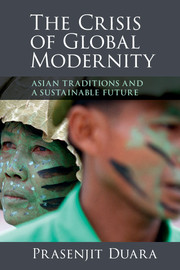Book contents
- Frontmatter
- Epigraph
- Contents
- List of figures and maps
- Preface and Acknowledgements
- Introduction
- 1 Sustainability and the crisis of transcendence
- 2 Circulatory and competitive histories
- 3 The historical logics of global modernity
- 4 Dialogical and radical transcendence
- 5 Dialogical transcendence and secular nationalism in the Sinosphere
- 6 The traffic between secularism and transcendence
- 7 Regions of circulation and networks of sustainability in Asia
- Reprise and Epilogue: of reason and hope
- Bibliography
- Index
- References
2 - Circulatory and competitive histories
Published online by Cambridge University Press: 05 January 2015
- Frontmatter
- Epigraph
- Contents
- List of figures and maps
- Preface and Acknowledgements
- Introduction
- 1 Sustainability and the crisis of transcendence
- 2 Circulatory and competitive histories
- 3 The historical logics of global modernity
- 4 Dialogical and radical transcendence
- 5 Dialogical transcendence and secular nationalism in the Sinosphere
- 6 The traffic between secularism and transcendence
- 7 Regions of circulation and networks of sustainability in Asia
- Reprise and Epilogue: of reason and hope
- Bibliography
- Index
- References
Summary
As a graduate student in the Boston area, I once encountered a stray sheet of paper in a library, the blank side of which I wished to use for notes. It was a photocopy of a handwritten page from an archived document of 1833, which mentioned the impending visit of the famous Unitarian from India to Salem, Massachusetts, Raja Rammohun Roy (1772–1833), who was currently visiting Bristol. In preparation for his visit, the Unitarians were circulating a locket with a curl of his hair in it. I was taken aback, because, as an Indian, I had known of Roy as the founder of the reformist Hindu Brahmo Samaj, a deist and the ‘father of modern India’; I also knew that he had visited England, but had no idea of his planned visit to the United States or that he was even known there, let alone the reverence with which he was held by some. Roy died in Bristol in 1833 and so never did step on the shores of Salem, although his ideas and a lock of hair had represented him there.
Over the years, I picked up other scattered pieces of information that began to coalesce into a remarkable history of circulations. For one thing, the New England Transcendentalists, particularly, Henry David Thoreau and Ralph Waldo Emerson, read Roy’s translations of the Upanishads and the principal Vedas, texts they deeply admired and cited profusely. They were doubtless familiar with the exchanges between Roy and the British Unitarians, which were published in 1824.
- Type
- Chapter
- Information
- The Crisis of Global ModernityAsian Traditions and a Sustainable Future, pp. 53 - 90Publisher: Cambridge University PressPrint publication year: 2014
References
- 1
- Cited by

